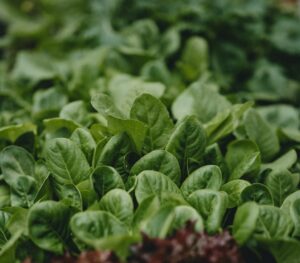The Best Time to Plant Spinach in Alabama
Gardening is enjoyable and rewarding for many people, especially when growing vegetables. Spinach is a popular vegetable to grow in Alabama due to its nutritious benefits and relatively easy-to-grow nature. Suppose you want your spinach plants to thrive in the Alabama climate. In that case, understanding ideal climate conditions, choosing a suitable variety, planting at the right time for maximum yields, proper care and maintenance tips, and frost protection strategies are all essential. In this blog post, we will provide you with a comprehensive guide on how to successfully grow spinach in Alabama so that you can reap the rewards of healthy and delicious homegrown spinach!
Ideal climate conditions for planting spinach in Alabama

Growing spinach in Alabama can be a rewarding experience when done correctly. Gardeners must understand the ideal climate conditions to help their spinach plants thrive. With the right soil type, temperature range, sun, and water needs, your spinach plants can yield delicious and nutritious greens throughout the growing season. Regarding the soil, spinach prefers a moist and well-drained environment. This means that gardeners should ensure their soil has good drainage so it does not get too soggy after watering or rain. The ideal temperature for growing spinach in Alabama is between 55°F and 65°F, making spring and fall some of the best times of year to plant your crop. Consider how much sun your plot receives; spinach can tolerate full sun or partial shade depending on preference and location.
You need to water your spinach regularly for optimal growth, but don’t overwater! Too much moisture can lead to wilting leaves, significantly reducing yields. Be mindful of frost during the colder months. If temperatures drop below 32°F, use a tarp or other protective material to shield plants from frost damage.
By following these tips for growing spinach in Alabama, you can create an environment where your crop will thrive! Remember these guidelines when planting this popular vegetable; you will soon enjoy fresh, homegrown greens all summer!
Choosing the right variety of spinach for Alabama
Choosing the right variety of spinach for Alabama is crucial in ensuring a successful harvest. Different varieties have different needs and requirements when it comes to temperature, water, and nutrients, so it is important to select a variety adapted to Alabama’s warm climate. Gardeners should consult their local county extension office to find out which varieties are best suited for their particular region and season, as some varieties are better suited for spring planting while others do better in the fall. The most popular spinach types grown in Alabama include Bloomsdale, Savoy, American, Tyee, and Space Spinach. Bloomsdale spinach grows best in warmer temperatures with plenty of light exposure. Still, it can withstand cooler temperatures if given adequate protection from frost. It produces large leaves with a wrinkled texture and has an excellent flavor. Savoy spinach generally has smaller leaves than Bloomsdale and grows in cooler temperatures during fall or early spring. American spinach can be planted earlier than other varieties due to its ability to tolerate heat and cold better than other types. Tyee spinach yields larger leaves than Bloomsdale or Savoy but requires more water for optimum growth. Finally, Space Spinach is known for its prolific yields even under cooler conditions, which makes it ideal for growing during late winter or early spring months in Alabama.
It’s also crucial to consider the soil type when selecting your variety of spinach for Alabama—some prefer sandy soils. In contrast, others do better with loam-based soils containing higher organic matter levels, such as compost or manure. Additionally, gardeners should consider how much sunlight their plot receives daily—spinach plants require at least 6 hours of full sun daily to produce healthy foliage and abundant harvests! With these considerations, gardeners can choose the perfect variety of spinach for their specific needs and conditions in Alabama!
When to plant spinach for maximum yields
Planting spinach in Alabama for maximum yields requires careful consideration of the climate and season. Spinach is usually planted between late winter and early spring when temperatures are mild and the soil has begun to thaw. Planting too early can result in frost damage while planting too late can lead to reduced yields due to warmer temperatures. The ideal temperature range for planting spinach is 45-75°F (7-24°C). Bloomsdale spinach should be planted as soon as the ground can be worked in mid-winter or late winter.
In contrast, Savoy spinach should be planted between late winter and early spring. American spinach can take a bit more cold and should be planted earlier than Bloomsdale or Savoy. Tyee spinach needs warm temperatures for optimal growth, so it should not be planted until after the last frost. Space Spinach is an especially hardy variety that will tolerate cold temperatures better than other varieties so that it can be planted at any time during the growing season in Alabama.
It’s important to consider successive plantings when planning your growing season. Planting a few rows of seeds every two weeks from mid-winter through spring will ensure a steady supply of fresh greens. Additionally, gardeners should wait until soil temperatures reach at least 50°F (10°C) before planting because cool soils will delay germination and slow growth rates. Harvesting begins approximately six weeks after planting when leaves are 2-3 inches tall; mature plants may require 45 days before reaching full size.
When harvesting spinach in Alabama, keep watch on nighttime temperatures since cool weather encourages fast growth and increases the risk of frost damage, which could significantly ruin your crop or delay its harvest date. If there’s a chance of frost coming overnight, protect your plants with blankets or row covers to keep them safe from harm. The most common pests affecting spinach include aphids, flea beetles, slugs, cutworms, and leaf miners; use preventive measures such as crop rotation and organic pest control methods such as beneficial insects or soap solutions to control these pests without harming your plants or the environment around them.
Care and maintenance tips for spinach grown in Alabama
Growing spinach in Alabama requires careful attention and maintenance to ensure plants thrive. To ensure success, gardeners should follow the following care and maintenance tips:Watering: Spinach plants need regular watering to prevent them from drying out. Water deeply, at least 1-2 inches weekly, either by hand or with a drip system. Avoid overhead watering when possible, as wet foliage can lead to disease and rot.
Pest & Disease Control: Monitor your spinach crop regularly for signs of pests or diseases such as aphids, flea beetles, slugs, cutworms, and leaf miners. To address an infestation, use organic pest control methods before applying chemical pesticides as a last resort. Additionally, rotate your crops to avoid soil-borne diseases that may affect your spinach crop.
Fertilization: Spinach needs plenty of nutrition to thrive in Alabama’s climate. Fertilize every four to six weeks using a balanced 10-10-10 fertilizer; alternatively, you can also use aged compost or manure. This will ensure that your spinach has enough nutrients for healthy growth throughout the season.
Mulching: Adding mulch around your spinach plants helps keep weeds down and conserve moisture in the soil during hot summer months; additionally, it helps protect plants from frost damage in cooler months. Use organic mulch such as straw or shredded leaves around plants about two inches deep on top of moist soil for best results.
Harvesting: Spinach is ready for harvest approximately six weeks after planting when leaves are fully grown but still tender and sweet-tasting; typically, this occurs between mid-spring and early summer in Alabama’s climate. Harvest carefully so as not to damage other surrounding vegetables or disrupt their root systems; cutting off the foliage at the base of the plant is recommended instead of pulling up by the roots, which can cause long-term damage to the crop.
By following these simple care and maintenance tips, gardeners can ensure healthy yields throughout the growing season in Alabama’s climate conditions – ensuring their spinach plants get all they need for optimal growth!
Frost protection strategies for spinach in Alabama
Frost protection is an essential part of growing spinach in Alabama. Cold temperatures can damage or kill spinach plants, so keeping your crop safe during winter is vital. A few strategies can be used to protect your spinach from frost, including using plastic or fabric row covers, mulching around the plants, and relocating sensitive plants to a sheltered area. Plastic or fabric row covers are one of the most effective methods for protecting spinach from frost. These materials are placed over rows of plants and provide an extra layer of insulation that keeps cold air away from them. This technique is handy for covering tender seedlings, raising temperatures to 8 degrees Fahrenheit. Planting in raised beds can also help insulate the soil and prevent frost damage.
Mulching around spinach plants is another way to protect them from frost damage. The mulch is an additional insulation layer that helps keep soil temperatures warmer throughout winter. It’s best to use organic material such as straw or wood chips for mulching since they will decompose slowly over time, providing continued insulation benefits throughout the season.
Finally, suppose you have susceptible varieties like Tyee or Savoy. In that case, it may be necessary to relocate them during cold weather months or severe frosts. Placing these plants near a wall or other structure will help protect them from cold winds and provide additional warmth from reflected heat off the walls themselves. Additionally, having a greenhouse can also come in handy for keeping delicate varieties safe during colder times of the year.
By following these guidelines on protecting your spinach plants in Alabama against frost damage, gardeners can ensure their crops will thrive throughout the growing season regardless of changing weather conditions.
